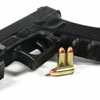
What The Glock
Story of ‘America’s gun’ is filled with intrigue, luck, ego, tragedy and marketing triumph
- By Ronnie Rittenberry
- Mar 01, 2012
It’s weird to think now, but prior to 30 years ago,
the best chance of encountering the word “glock”
was in the funny pages, where it might have been
used as an interjection to suggest a heavy blow. Its
existence as a proper noun, at least in popular culture,
did not exist until 1982, when a then-humble
machinist and engineer named Gaston Glock created
the eponymous handgun that would revolutionize the
firearms industry.
As told in journalist Paul M. Barrett’s Glock: The
Rise of America’s Gun, it did not take long before the
name was a household word, at least among those
who knew firearms, law enforcement agents in particular.
By the early ‘90s, most of the rest of us had at
least heard the word—whether in cop shows, movies
or rap songs—and were able to identify it as a synonym
for a cutting-edge, lethal weapon and force to
be reckoned with in the gun world.
Memorably, for example, Bruce Willis as Lt. John
McClane in 1990’s “Die Hard 2” yelled to an airport
police captain: “That punk pulled a Glock 7 on me!
You know what that is? It’s a porcelain gun made in
Germany. It doesn’t show up on your airport X-ray
machines, and it costs more than you make here in
a month!”
As Barrett notes in his book, “It didn’t matter
that every single trait Willis/McClane ticked
off about the pistol was incorrect: There was never
a model called the Glock 7. The gun was made in
Austria, not Germany. It did show up on airport Xray
machines, and the Glock didn’t cost more than
what a police captain made in a month.” The scene
nevertheless helped to do for Glock Inc. what Clint
Eastwood as “Dirty Harry” Callahan did for Smith
& Wesson and its .44 Magnum.
Like Glockwork
Barrett does a thorough job of chronicling the short
time between the gun’s invention and its whirlwind
achievement of near-icon status, and the tale is, in its
way, riveting. As is often the case with mass-accepted
products, much of the Glock’s wild success had to do
with its being at the right place at the right time.
One of the watershed episodes in the story of the
Glock’s rise, as Barrett tells it, was an infamous 1986
shootout in Miami between two bank robbers and eight
FBI agents. Despite being outnumbered four to one, the
robbers, armed with semiautomatic weapons, killed two
of the agents and wounded five others before being taken
down. The agents, like most other federal and local law
enforcement officers at the time, had been armed with
standard six-shot revolvers. The incident led to the introduction
of more powerful handguns, both in the FBI
and in police departments around the United States.
Compared to the Smith & Wesson .38 revolvers
that were, up to that point, de rigueur in most departments,
the pioneering semiautomatic Glock 17
nine-millimeter was lighter weight, had fewer and interchangeable
parts, could fire as many as 17 bullets
from its large-capacity spring-action magazine without
reloading, and could be reloaded more quickly. In
short, officers flocked to the Glock. Today, the Austrian
pistol has been embraced by two-thirds of all
U.S. police departments.
Glock, Stock and Barrel
“The American civilian gun-buying population tends to
gravitate toward what the professionals carry,” Barrett
writes. “For Glock, that translated into a bonanza.”
So ubiquitous did the Glock become that it was
just a matter of time before it was as much a part of
the arsenals of the criminal and disturbed as it was of
the forces of good.
Among the high-profile tragedies Barrett devotes
attention to is the one that took place Oct. 16, 1991,
at a Luby’s cafeteria in Killeen, Texas. After smashing
his pickup through the restaurant’s plate-glass
window, George Hennard shot 22 people dead and
wounded at least 20 others before turning his Glock
17 on himself, committing suicide by putting a bullet
through his left eye. At the time, the incident’s 23
deaths made the attack the worst mass shooting ever
to occur in the United States.
Unfortunately, that dark distinction later belonged
to the massacre at Virginia Tech, where on April 16,
2007, student Seung-Hui Cho killed 32 people and
wounded 25 others before committing suicide. One of
the guns Cho used was a Glock 19 nine-millimeter.
Although he could, Barrett does not use such incidents
to polarize his narrative of the Glock’s evolution.
Rather, keeping in mind the good the gun
has done for law enforcement and security-minded
homeowners, and maintaining a mostly even-handed
perspective, he concludes that the Glock “is not
a particular villain within the fraternity of firearms.
Nor is it a hero—regardless of what Hollywood tells
us on both scores. As a weapon, a means of self-defense,
and a source of recreation, the Austrian pistol
has many positive attributes. It also has aspects now
shared by many brands, such as large ammunition capacity,
that can be problematic, even fatal.”
This article originally appeared in the March 2012 issue of Security Today.